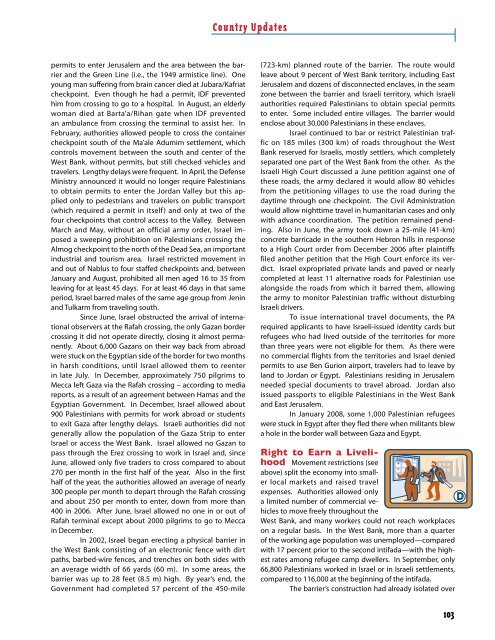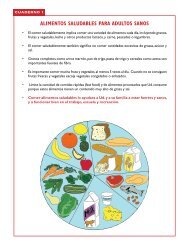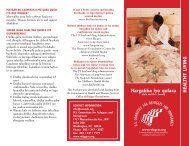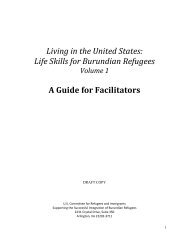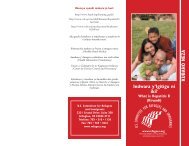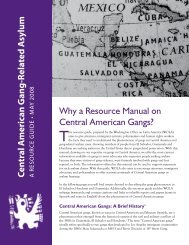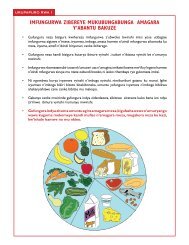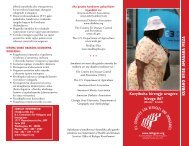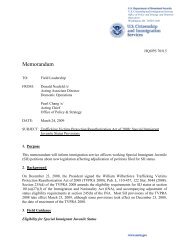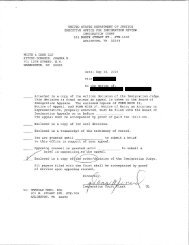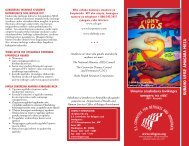Refugees and Asylum Seekers
Refugees and Asylum Seekers
Refugees and Asylum Seekers
Create successful ePaper yourself
Turn your PDF publications into a flip-book with our unique Google optimized e-Paper software.
permits to enter Jerusalem <strong>and</strong> the area between the barrier<br />
<strong>and</strong> the Green Line (i.e., the 1949 armistice line). One<br />
young man suffering from brain cancer died at Jubara/Kafriat<br />
checkpoint. Even though he had a permit, IDF prevented<br />
him from crossing to go to a hospital. In August, an elderly<br />
woman died at Barta’a/Rihan gate when IDF prevented<br />
an ambulance from crossing the terminal to assist her. In<br />
February, authorities allowed people to cross the container<br />
checkpoint south of the Ma’ale Adumim settlement, which<br />
controls movement between the south <strong>and</strong> center of the<br />
West Bank, without permits, but still checked vehicles <strong>and</strong><br />
travelers. Lengthy delays were frequent. In April, the Defense<br />
Ministry announced it would no longer require Palestinians<br />
to obtain permits to enter the Jordan Valley but this applied<br />
only to pedestrians <strong>and</strong> travelers on public transport<br />
(which required a permit in itself ) <strong>and</strong> only at two of the<br />
four checkpoints that control access to the Valley. Between<br />
March <strong>and</strong> May, without an official army order, Israel imposed<br />
a sweeping prohibition on Palestinians crossing the<br />
Almog checkpoint to the north of the Dead Sea, an important<br />
industrial <strong>and</strong> tourism area. Israel restricted movement in<br />
<strong>and</strong> out of Nablus to four staffed checkpoints <strong>and</strong>, between<br />
January <strong>and</strong> August, prohibited all men aged 16 to 35 from<br />
leaving for at least 45 days. For at least 46 days in that same<br />
period, Israel barred males of the same age group from Jenin<br />
<strong>and</strong> Tulkarm from traveling south.<br />
Since June, Israel obstructed the arrival of international<br />
observers at the Rafah crossing, the only Gazan border<br />
crossing it did not operate directly, closing it almost permanently.<br />
About 6,000 Gazans on their way back from abroad<br />
were stuck on the Egyptian side of the border for two months<br />
in harsh conditions, until Israel allowed them to reenter<br />
in late July. In December, approximately 750 pilgrims to<br />
Mecca left Gaza via the Rafah crossing – according to media<br />
reports, as a result of an agreement between Hamas <strong>and</strong> the<br />
Egyptian Government. In December, Israel allowed about<br />
900 Palestinians with permits for work abroad or students<br />
to exit Gaza after lengthy delays. Israeli authorities did not<br />
generally allow the population of the Gaza Strip to enter<br />
Israel or access the West Bank. Israel allowed no Gazan to<br />
pass through the Erez crossing to work in Israel <strong>and</strong>, since<br />
June, allowed only five traders to cross compared to about<br />
270 per month in the first half of the year. Also in the first<br />
half of the year, the authorities allowed an average of nearly<br />
300 people per month to depart through the Rafah crossing<br />
<strong>and</strong> about 250 per month to enter, down from more than<br />
400 in 2006. After June, Israel allowed no one in or out of<br />
Rafah terminal except about 2000 pilgrims to go to Mecca<br />
in December.<br />
In 2002, Israel began erecting a physical barrier in<br />
the West Bank consisting of an electronic fence with dirt<br />
paths, barbed-wire fences, <strong>and</strong> trenches on both sides with<br />
an average width of 66 yards (60 m). In some areas, the<br />
barrier was up to 28 feet (8.5 m) high. By year’s end, the<br />
Government had completed 57 percent of the 450-mile<br />
(723-km) planned route of the barrier. The route would<br />
leave about 9 percent of West Bank territory, including East<br />
Jerusalem <strong>and</strong> dozens of disconnected enclaves, in the seam<br />
zone between the barrier <strong>and</strong> Israeli territory, which Israeli<br />
authorities required Palestinians to obtain special permits<br />
to enter. Some included entire villages. The barrier would<br />
enclose about 30,000 Palestinians in these enclaves.<br />
Israel continued to bar or restrict Palestinian traffic<br />
on 185 miles (300 km) of roads throughout the West<br />
Bank reserved for Israelis, mostly settlers, which completely<br />
separated one part of the West Bank from the other. As the<br />
Israeli High Court discussed a June petition against one of<br />
these roads, the army declared it would allow 80 vehicles<br />
from the petitioning villages to use the road during the<br />
daytime through one checkpoint. The Civil Administration<br />
would allow nighttime travel in humanitarian cases <strong>and</strong> only<br />
with advance coordination. The petition remained pending.<br />
Also in June, the army took down a 25-mile (41-km)<br />
concrete barricade in the southern Hebron hills in response<br />
to a High Court order from December 2006 after plaintiffs<br />
filed another petition that the High Court enforce its verdict.<br />
Israel expropriated private l<strong>and</strong>s <strong>and</strong> paved or nearly<br />
completed at least 11 alternative roads for Palestinian use<br />
alongside the roads from which it barred them, allowing<br />
the army to monitor Palestinian traffic without disturbing<br />
Israeli drivers.<br />
To issue international travel documents, the PA<br />
required applicants to have Israeli-issued identity cards but<br />
refugees who had lived outside of the territories for more<br />
than three years were not eligible for them. As there were<br />
no commercial flights from the territories <strong>and</strong> Israel denied<br />
permits to use Ben Gurion airport, travelers had to leave by<br />
l<strong>and</strong> to Jordan or Egypt. Palestinians residing in Jerusalem<br />
needed special documents to travel abroad. Jordan also<br />
issued passports to eligible Palestinians in the West Bank<br />
<strong>and</strong> East Jerusalem.<br />
In January 2008, some 1,000 Palestinian refugees<br />
were stuck in Egypt after they fled there when militants blew<br />
a hole in the border wall between Gaza <strong>and</strong> Egypt.<br />
Right to Earn a Livelihood<br />
Movement restrictions (see<br />
above) split the economy into smaller<br />
local markets <strong>and</strong> raised travel<br />
expenses. Authorities allowed only<br />
a limited number of commercial vehicles<br />
to move freely throughout the<br />
West Bank, <strong>and</strong> many workers could not reach workplaces<br />
on a regular basis. In the West Bank, more than a quarter<br />
of the working age population was unemployed—compared<br />
with 17 percent prior to the second intifada—with the highest<br />
rates among refugee camp dwellers. In September, only<br />
66,800 Palestinians worked in Israel or in Israeli settlements,<br />
compared to 116,000 at the beginning of the intifada.<br />
The barrier’s construction had already isolated over<br />
Jobs<br />
D<br />
103


